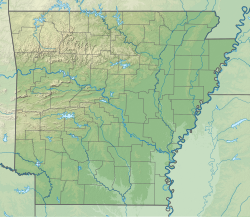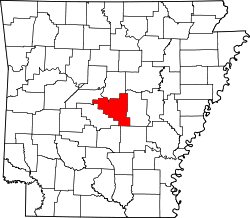North Little Rock | |
|---|---|
| City of North Little Rock | |
 | |
| Motto: “Up for Something!” | |
 Location of North Little Rock in Pulaski County, Arkansas | |
| Coordinates: 34°46′51″N92°15′25″W / 34.78083°N 92.25694°W | |
| Country | |
| State | |
| County | Pulaski |
| Township | Hill |
| Founded | April 18, 1871 |
| Incorporated | July 17, 1901 |
| Named after | Little Rock, Arkansas |
| Government | |
| • Type | Mayor–Council |
| • Mayor | Terry Hartwick |
| • Council | North Little Rock City Council |
| Area | |
| 56.20 sq mi (145.55 km2) | |
| • Land | 53.04 sq mi (137.38 km2) |
| • Water | 3.15 sq mi (8.16 km2) |
| Elevation | 256 ft (78 m) |
| Population (2020) | |
| 64,591 | |
• Estimate (2024) | 65,214 |
| • Rank | US: 524th |
| • Density | 1,217.69/sq mi (470.15/km2) |
| • Urban | 431,388 (US: 88th) |
| • Metro | 729,135 (US: 75th) |
| Time zone | UTC−6 (CST) |
| • Summer (DST) | UTC−5 (CDT) |
| ZIP codes | 72114-119, 721124, 72190, 72199 |
| Area code | 501 |
| FIPS code | 05-50450 |
| GNIS feature ID | 2404393 [2] |
North Little Rock (often abbreviated "NLR") is a city in Pulaski County, Arkansas, United States. Located on the north side of the Arkansas River, it is the twin city of Little Rock. In the late nineteenth century, it was annexed by Little Rock for a period, but regained its independence in the early 20th century. The population was 64,591 at the 2020 Census, making it the seventh-most populous city in Arkansas.
Contents
- History
- Geography
- Neighborhoods
- Climate
- Demographics
- 2020 census
- 2010 census
- Arts and culture
- Points of interest
- Sports
- Parks and recreation
- Government
- Intergovernmental relations
- Education
- Public primary and secondary schools
- Private primary and secondary schools
- Post-secondary education
- Public libraries
- Infrastructure
- Transportation
- Police
- Fire department
- Hospitals
- Notable people
- Sister cities
- Notes
- References
- External links
The city has invested in significant beautification efforts since the late 20th century. Young families and professionals have shown new interest in this area. The Argenta Historic District in Downtown is one of a number of areas that have developed as thriving entertainment districts offering theaters, fine dining, bars, gastropubs, and boutiques.
It is also home to Dickey-Stephens Park, which hosts the Arkansas Travelers minor league baseball team. Simmons Bank Arena is the metropolitan area's main entertainment venue. Farther west is Burns Park, one of the largest municipal parks in the United States.





